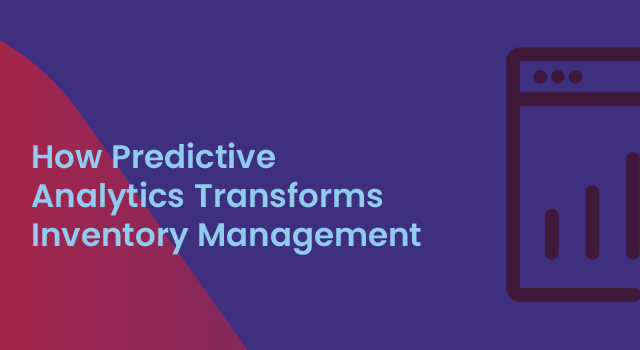Supply chain disruptions and unpredictable demand can leave you with too much stock or costly shortages. Traditional forecasting methods just don’t cut it anymore – but smarter, data-driven planning can help you stay ahead, reduce risks, and accelerate profits.
Imagine this: You’re a retailer gearing up for a busy season, but suddenly demand spikes for a product you didn’t anticipate. Now, you’re scrambling to restock, but the shelves are already empty. Or, you’ve overstocked and now have to deal with unsold inventory eating up storage space. Sound familiar?
By using accurate forecasts, you can place the right orders and track sales more effectively. Analyzing historical data helps you make smarter decisions on inventory levels and market trends, so you can avoid these scenarios in the future.
The challenge? Predicting demand is tough, especially with constant disruptions. As an inventory planner, you can’t just rely on past sales data. You need to consider multiple data points to forecast future sales accurately and determine the right stock levels—avoiding both overstocking and stock-outs.
In this article, we’ll explore:
1. What is inventory forecasting?
“If you don’t know what you will sell tomorrow, how will you know what to buy today?” – Barry Kukkuk, Founder of Netstock. This sums up the essence of inventory forecasting.
In simple terms, inventory forecasting uses historical sales data and other key information to predict future demand. Why is this important? A reliable forecast ensures you have the right amount of stock on hand, reducing excess inventory and improving profit margins.
For each SKU -ask yourself:
- How many units should I order?
- How much safety stock is required?
- How often should I reorder?
- What’s the reorder level?
- How will the minimum order quantity affect future orders?
- What inventory will we need in three or six months to improve the fill rate?
To create an accurate forecast, gather data from multiple sources:
- Current inventory levels
- Open purchase orders
- Historical sales data
- Supplier lead times
- Customer trends and seasonality
- Input from sales and marketing teams
- Insights from past marketing or promotional campaigns
An inventory management solution helps automate and integrate these data points, making forecasting and inventory management more efficient.
Collaboration is essential. Regular meetings with sales, operations, and marketing teams keep everyone aligned. For instance, knowing about upcoming promotions or past campaign results helps adjust stock levels. Sales teams can also share valuable insights about suppliers and customers, which boosts forecast accuracy.
2. Four main inventory forecasting methods
To achieve an accurate inventory forecast, it’s important to choose the right forecasting method that aligns with your business strategy, goals, and timelines.
According to g2.com, the key difference between quantitative and qualitative data is simple: quantitative data can be measured and expressed with numbers, while qualitative data is descriptive and conceptual, focusing on traits and characteristics.
- Qualitative forecasting: When historical data is not available, the forecasting is largely based on “gut feeling,” market intel, and insights on the existing customer base. This is often the case when you stock a new product. The method will draw on insights from the sales team, marketing team, or other market research. Some businesses will also utilize the Delphi method. According to invenstopedia.com, the “Delphi method is a process used to arrive at a group opinion or decision by surveying a panel of experts.” Other examples of qualitative methods are using surveys and scenario building.
- Quantitative forecasting: This method uses data and collates information from various data points to provide a prediction of future demand. This method draws on data from:
- Previous sales and past revenue for the last 12 months
- Historical inventory
- Surplus stock volumes
- Seasonality
Alternative methods that demand planners can use:
- Trend forecasting: With changes in customer demand, this forecasting method reviews stock trends over a period of time. While this method will predict trends, it does not factor in seasonality or sudden spikes or declines. This method is generally used to showcase the kinds of stock items the customer is interested in, and this data will help sales and marketing teams with potential sales campaigns.
- Graphical forecasting: This method of forecasting is visual, and often, this method is easier to understand. Graphical forecasting will use the same data as you would for trend forecasting and merely create a visual representation of the data. This method will show you your stock’s general upward or downward sales movement without going into too much detail.
3. Essential activities to improve inventory forecasting
Since each stock item will have its own demand, no sales forecast will be the same. Ideally, you need to independently capture the monthly sales history for each item in each location and perform monthly and weekly activities. However, before you do that, you should first classify your inventory.
Inventory classification
An inventory holding business will typically have hundreds or even thousands of different stock items, and you must identify your high-moving and slow-moving items. A vital step to improving your forecasting process is to classify your inventory to focus on the right stock items that make you the most profit.
When you classify your inventory, you will immediately know:
- Your fast-moving items,
- your slow-moving items and,
- what items need to become obsolete or non-stocked.
Monthly forecasting activities
Use a forecast engine to create computer-generated forecasts for all of your items. Use sales or demand history to generate a forecast. Pick up on trends, seasonality, intermittent demand, one-off sales spikes, and factors in data such as lost sales. Any worthy forecast engine will generate forecasts by using several different algorithms. Once done, it should compare all of the generated forecasts with the sales, or demand history to determine the “best fit” forecast. This results in accurate forecasts for the bulk of your items.
A small percentage of your items will need manual intervention, as no forecast engine will get every forecast right. Monitor those items with consistent variances between sales and forecast:
- Adjust the forecast up where sales have consistently exceeded the forecast.
- Adjust the forecast down where sales have consistently been lower than the forecast.
- Aligning sales and forecasts means there is less risk of generating excess inventory or experiencing costly stock-outs.
Adjust your forecast for new or lost customers as soon as you are aware of the change. Use the computer forecast, but:
- Subtract a lost customer’s monthly demand.
- Add in new customer’s expected monthly demand.
Since new items will have no sales history, these need to be manually forecasted for the first few months. Check to make sure that the “new” item is not a replacement for a product, where a cheaper or better quality product has been sourced and will now be sold instead of the old product. In this instance, you would link the “new” item to the “old” item, which results in the sales history of the old item being used to generate the forecast for the new item. This has the benefit of getting an earlier indication of forecast accuracy, which is vital to getting the right safety stock in place sooner.
Adjust forecasts to include additional promotional demand on top of the expected regular sales. Use team discussions and inputs to help guide these adjustments. Better input leads to more accurate forecasts, better stock levels, and a more successful promotion!
Report on forecasting performance and make sure your measure also distills the bias between over-and-under forecasting. Measuring the difference between your system-generated forecast and the manually adjusted forecast is helpful to establish whether the manual intervention improved the result.
Conduct a sanity check at a macro level. After making changes to individual item forecasts on an exception basis, review overall sales to forecast to ensure that the overall growth is not too extreme or too conservative. Most forecasting applications will enable macro forecast adjustments to be made, should they be required.
Weekly forecasting activities
Weekly activities highlight exceptions between the pro-rated forecast and the actual sales. Here, any severe deviations between sales and pro-rated forecasts highlight potential issues with the forecast for individual items. Reviewing these alerts enables prompt response to possible changes in demand.
Review forecasts for the top 5-10 sales versus forecast exceptions:
- Increase your forecast – if you are selling more
- Reduce your forecast – if you are selling less
- Consider that you may be selling less due to stock-outs
4. Benefits of an effective forecasting process
It’s a common belief that if your forecast is spot-on, your supply chain will run smoothly—but that’s not always the case. Unfortunately, no forecasting system is perfect, and there will always be some bumps along the way.
Just importing data from your ERP into a spreadsheet won’t give you an accurate forecast. Sure, Excel has some forecasting formulas, but they’re built for small, simple data sets, not for managing hundreds or thousands of items. By the time you update everything, the data could be outdated—and that’s a perfect recipe for errors.
The key to better forecasting? To stay competitive, invest in inventory and demand planning solutions that unlock the data in your ERP, providing the visibility needed to create accurate sales forecasts—taking seasonality, trends, and potential problem areas into account.
When you have a structured process in place, you’ll start to see improvements in your forecast:
- Happy customers, who receive the right stock on time and in full
- Reduced stock-outs, you won’t miss out on any potential sales
- Less safety stock , your order recommendations will be accurate
- Reduction of your slow-moving and obsolete stock, you won’t order more of these items by classifying your stock items
- A focused sales strategy, accurate forecasts are useful for sales and marketing when planning their promotional campaigns




